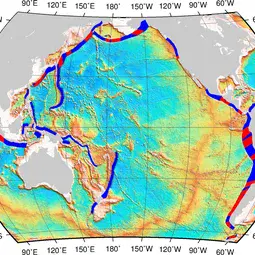Scientists pinpoint great-earthquake hotspots
The world’s largest earthquakes occur at subduction zones – locations where a tectonic plate slips under another. But where along these extended subduction areas are great earthquakes most likely to happen? Scientists have now found that regions where ‘scars’ on the seafloor, called fracture zones, meet subduction areas are at higher risk of generating powerful earthquakes. The results are published today in Solid Earth, an open access journal of the European Geosciences Union (EGU).
“We find that 87% of the 15 largest (8.6 magnitude or higher) and half of the 50 largest (8.4 magnitude or higher) earthquakes of the past century are associated with intersection regions between oceanic fracture zones and subduction zones,” says Dietmar Müller, researcher at the University of Sydney in Australia and lead author of the Solid Earth paper. The connection is less striking for smaller earthquakes.
Powerful earthquakes related to these intersection regions include the destructive 2011 Tohoku-Oki and 2004 Sumatra events.
“If the association we found were due to a random data distribution, only about 25% of great subduction earthquakes should coincide with these special tectonic environments. Therefore, we can rule out that the link we found is just due to chance,” he adds.
The researchers considered about 1,500 earthquakes in their study. They used a database of significant post-1900 events, as well as geophysical data mapping fracture zones and subduction zones, among others. They analysed information from these databases by using a specific data mining method.
“The method was originally developed for analysing online user data,” says Thomas Landgrebe, also involved in the study. “The technique we apply is commonly used to find a few specific items which are expected to be most appealing to an Internet user. Instead, we use it to find which tectonic environment is most suitable for generating great earthquakes.”
Since earthquake generation is a very complex process, the scientists don’t yet have a complete understanding of why great earthquakes prefer the intersection areas. They suggest that it is due to the physical properties of fracture zones, which result in “strong, persistent coupling in the subduction boundaries,” Landgrebe explains. This means that the subduction fault area is locked and thus capable of accumulating stress over long periods of time.
“The connection we have uncovered provides critical information for seismologists to, in the long run, pinpoint particular tectonic environments that are statistically more prone to strong seismic coupling and great earthquake supercycles,” Müller says. An area with earthquake supercycles experiences recurring powerful earthquakes every few centuries or millennia.
Regions that have long earthquake supercycles are usually not picked up as risk areas by seismic hazard maps as these are constructed mainly using data collected after 1900. An example is the area of the 2011 Tohoku-Oki earthquake, which had no record of large earthquakes over the past century and was not predicted to be of significant risk by previous hazard maps.
“The power of our new method is that it does pick up many of these regions and, hence, could contribute to much-needed improvements of long-term seismic hazard maps,” Müller explains.
“Even though we don’t fully understand the physics of long earthquake cycles, any improvements that can be made using statistical data analysis should be considered as they can help reduce earthquake damage and loss of life.”
Note
The floor of the Earth’s oceans is crossed by underwater mountain systems, or ocean ridges, such as the mid-Atlantic ridge that runs from north to south between the Americas and Africa. These ridges divide two tectonic plates that move apart as lava emerges from the opening, spreading the sea floor. The mid-ocean ridge jogs back and forth at offsets known as transform faults, creating zig-zagged plate boundaries. Fracture zones are scars in the ocean floor left by these transform faults.
More information
This research is presented in the paper ‘The link between great earthquakes and the subduction of oceanic fracture zones’ published in the EGU open access journal Solid Earth on 5 December 2012.
The scientific article is available online at: http://www.solid-earth.net/3/447/2012/se-3-447-2012.html
The discussion paper (before peer review) and reviewers comments are available at http://www.solid-earth-discuss.net/4/1229/2012/sed-4-1229-2012.html
The team is composed of Dietmar Müller and Thomas Landgrebe, both of the EarthByte Group, School of Geosciences, University of Sydney (Australia).
The European Geosciences Union (EGU) is Europe’s premier geosciences union, dedicated to the pursuit of excellence in the Earth, planetary, and space sciences for the benefit of humanity, worldwide. It is a non-profit interdisciplinary learned association of scientists founded in 2002. The EGU has a current portfolio of 14 diverse scientific journals, which use an innovative open-access format, and organises a number of topical meetings, and education and outreach activities. Its annual General Assembly is the largest and most prominent European geosciences event, attracting over 10,000 scientists from all over the world. The meeting’s sessions cover a wide range of topics, including volcanology, planetary exploration, the Earth’s internal structure and atmosphere, climate, energy, and resources. The 2013 EGU General Assembly is taking place is Vienna, Austria from 7-12 April. For information regarding the press centre at the meeting and media registration, please check http://media.egu.eu.
If you wish to receive our press releases via email, please use the Press Release Subscription Form. Subscribed journalists and other members of the media receive EGU press releases under embargo (if applicable) 24 hours in advance of public dissemination.
Contact
Dietmar Müller
University of Sydney
Sydney, Australia
Phone +61-2-9036-6533
Email dietmar.muller@sydney.edu.au
Bárbara Ferreira
EGU Media and Communications Officer
Munich, Germany
Phone +49-89-2180-6703
Email media@egu.eu
Links
- Read this press release in simplified language, aimed at 7–13 year olds, on our Planet Press site


